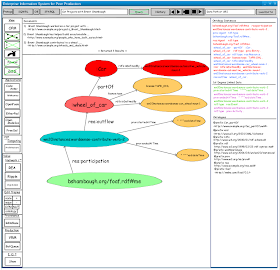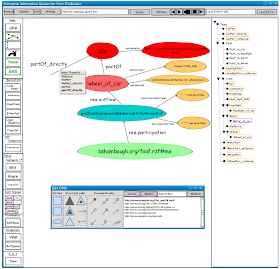Saturday, December 27, 2014
Links to "Building Social Applications with Linked Data Platform"
These March 2014 presentations give thoughts from Sandro Hawke, Andrei Sambra, and Tim Berners Lee, and others about the social web and a prototype called cimba.co with an illustration of the linked data platform at rww.io.
Building Social Applications with Linked Data Platform (LDP) -- Crosscloud --
Building Social Applications with Linked Data Platform (LDP) -- Crosscloud -- Part 3 <https://www.youtube.com/watch?v=ldfx1CdPsNQ>
Thursday, December 25, 2014
Installing Longwell Links
Contains information about openrdf:
http://rdf4j.org/sesame/2.7/docs/users.docbook?view
Whirlycache was mentioned by Longwell:
https://code.google.com/p/whirlycache/
http://rdf4j.org/sesame/2.7/docs/users.docbook?view
Whirlycache was mentioned by Longwell:
https://code.google.com/p/whirlycache/
Wednesday, December 24, 2014
Linked data Links
Linked Data Platform Implementations:
https://www.w3.org/wiki/LDP_Implementations
Marbles References:
http://mes.github.io/marbles/
http://wifo5-03.informatik.
Linked Data Tools:
http://linkeddata.org/tools
DIG Projects:
https://github.com/linkeddata
https://www.w3.org/wiki/LDP_Implementations
Marbles References:
http://mes.github.io/marbles/
http://wifo5-03.informatik.
Linked Data Tools:
http://linkeddata.org/tools
DIG Projects:
https://github.com/linkeddata
Thursday, December 18, 2014
Searching for Geolocation / GeoSpatial Material
W3C Geospatial Ontologies:
http://www.w3.org/2005/Incubator/geo/XGR-geo-ont-20071023/
Geolocation API Specification:
http://dev.w3.org/geo/api/spec-source.html
Geolocation Working Group
http://www.w3.org/2008/geolocation/
Mark Pilgrim's Chapter of the Gelocation API spec in HTML5
http://diveintohtml5.info/geolocation.html
http://www.w3.org/2005/Incubator/geo/XGR-geo-ont-20071023/
Geolocation API Specification:
http://dev.w3.org/geo/api/spec-source.html
Geolocation Working Group
http://www.w3.org/2008/geolocation/
Mark Pilgrim's Chapter of the Gelocation API spec in HTML5
http://diveintohtml5.info/geolocation.html
Sunday, December 14, 2014
Monthly Update for December (in response to the Open Apps Ecosystem monthly updates)
Over the past several months I have been wire framing EISPP, or Enterprise Information System for Peer Production. By Enterprise Information System (http://en.wikipedia.org/wiki/Enterprise_information_system) I mean a way to handle large amounts of information for business. By using the term Peer Production (http://en.wikipedia.org/wiki/Peer_production), I am describing the structure of the enterprise. I do believe that the system could be flexible enough to handle any form of enterprise, so it could be a more generic enterprise system.
Note that the licence URIs may need to be expressed with ODRL (
Also P2P Computing in the architecture section, Internet of Things (I.O.T.), faceted browsing (see Simile Longwell), triple storage (such most used locally for faster querying), and loading data will need to be explored.
What is holding me up? To an extent other things, but also how fast I can think.
What motivates me most in this time? The prospect that doing this will open up new ways of doing things that will be affordable (which will hopefully lead to diverse projects in diverse fields).
The entry point may be in a browser, or
in some other form that uses HTTP. I imagine this entry point to look
like this:
This entry point does not represent the
entire enterprise information system, but is merely a portal to it.
It is a portal to the underlying data which would exist in a
federated global database. There could be many of these portals both
viewing data, and performing transformations on it. Indeed, the
portal pictured above may not be the only type of portal.
One entry point, perhaps the most user
friendly, would be the natural language query. If I searched, for
example, for “Car Projects with Brent Shambaugh” I would get a
set of documents containing Car Projects and Brent Shambaugh, a
document with the term automobile that is semantically related to
car, and a document describing what I contributed to (a wheel). I
would also get ontology instances, the ontologies that they used, and
through following specified linked data links I could get 1st degree
linked data. Since some of these triples have common subjects or
objects they can form an interconnected graph. The subjects and
objects are nodes, while the connections between them are predicates.
This would be possible by searching an
ontology index, a document index, and an annotations index linking
the ontologies (including triples with instances of them) with the
documents. This method came from Miriam Fernandez's Thesis titled,
“Semantically enhanced Information Retrieval: an ontology based
approach” (http://nets.ii.uam.es/miriam/thesis.pdf).
Also a SPARQL query (http://www.w3.org/TR/sparql11-overview/)
or linked data browser
(http://www.w3.org/wiki/TaskForces/CommunityProjects/LinkingOpenData/SemWebClients)
could help find 1st degree linked data (check this).
There may come a point where I wish to
search amongst the data that was returned through the natural
language query in such a way that I follow the same semantic
relations. I could do this by using Enrico Franconi et al.'s method
presented in “An intelligent query interface based on ontology
navigation ” (http://ceur-ws.org/Vol-565/paper3.pdf).
At the beginning the query (excluding natural language equivalents)
would involve the parent class Thing, as shown below:
Completing the query with the graph
pattern “Car hasPart Reflector” would give: (cover GSS button)
- I need to double check how the underlying query / search would be performed. Perhaps with an ontology instance index as in M. Fernandez's Thesis. To make it P2P, try Yacy with alternating master and slave nodes. Inspired by: (http://www.academia.edu/2821203/P2P-MapReduce_Parallel_data_processing_in_dynamic_Cloud_environments). Or perhaps if the URIs of the data sources are known, a federated sparql query (http://www.w3.org/TR/2010/WD-sparql11-federated-query-20100601/).Alternatively, I may want to perform a SPARQL query..perhaps by using the existing graph as a base, and keeping the subjects and objects as variables. In this case, the query is restricted to data that exists in one rdf graph in one graph store (a database containing rdf graphs).
Completing this query would give:
(update ontology instances on right side)
What if I wanted to prune triples from
the resulting query? I can illustrate this on the original query “Car
Projects with Brent Shambaugh”. If I elimate all triples with
predicates rdf:type with fresnel lenses
(http://www.w3.org/2005/04/fresnel-info/)
I obtain: (eliminate triples from ontology instances and 1st degree
linked data)
I can enhance my view by applying color
coding triples with graph style sheets
(http://www.w3.org/2001/11/IsaViz/gss/gssmanual.html).
Applying, I obtain:
I can also add triples to the graph
likely using the web widgets library developed by Hollenbach et al.
(http://dig.csail.mit.edu/2010/rdf-widgets/thesis.pdf
) and maintaining awareness of access control
(http://dig.csail.mit.edu/2009/Papers/ISWC/rdf-access-control/paper.pdf).
An alternative way to view query
results could be Dov Dori's Object Process Methodology which gives
natural language equivalents for triples in the graph:
Notice that if I select the wheel of
the car I see the corresponding ontology that it is from in the right
hand pane (alternatively, this I might try instances from the
ontology that are currently in use):
The previous highlighting is not native to OPM. Adding the git for triples (R&WBase)
(http://ceur-ws.org/Vol-996/papers/ldow2013-paper-01.pdf)
view plus a fresnel and GSS gives:
I can also show the case of two
different contributors to the same wheel:
I also may want to show the case where
an external agent compensates another agent for a contribution to
illustrate McCarthy's Resource Event Agent Methodology
(https://www.msu.edu/user/mccarth4/McCarthy.pdf)
(although I am not sure if it is correct OPM form to put an arrow
link between the the paid and contribute processes):
I also may show what seems to be behind
this transaction occuring over the ripple network with its metadata
being expressed as linked data in the PaySwarm
(https://web-payments.org/)
form:
Note that the licence URIs may need to be expressed with ODRL (
I could also show another contribution
to the car, such as a motor, using the REA methodology:
Applications are kind of tricky. There
needs to be a way to go from whatever things are called in the
displayed graph to whatever they are called in the database of the
application, say FreeCAD. Part 2 of ISO 15926 provides a reference
data library to map to and from a database. Below is a generic form
of figure 1.12 on page 34 of “Introduction to ISO15926”
(https://www.posccaesar.org/wiki/ISO15926Primer).
But we also need a way to relate things
by different names. Perhaps this is where part 2 of ISO 15926 comes
in. It is an upper ontology called EXPRESS.
I also may want to attach conversations
to particular projects. I might do this using rww.io and cimba.co
(https://github.com/deiu/rww.io
, https://github.com/linkeddata/cimba
). RWW.io may be used with cimba and data is stored as RDF which I'm
guessing could reference to triples in the projects.
What to do for next month? In addition
to the doubts above (e.g. parenthesis after colons), editing slides
for OPM will need to be completed. Here is starting out using
entities, and structural and procedural links from OPM.
VRM slides will also need to be
expanded. VRM follows VRM principles
(http://cyber.law.harvard.edu/projectvrm/Main_Page).
Also P2P Computing in the architecture section, Internet of Things (I.O.T.), faceted browsing (see Simile Longwell), triple storage (such most used locally for faster querying), and loading data will need to be explored.
What is holding me up? To an extent other things, but also how fast I can think.
What motivates me most in this time? The prospect that doing this will open up new ways of doing things that will be affordable (which will hopefully lead to diverse projects in diverse fields).


















